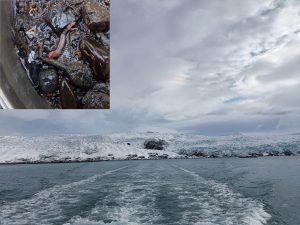Project description
 Glaciers cover most of Svalbard, which means that in many fjords, the seafloor is churned up by large ice sheets and massive amounts of sediment and rocks are deposited into the water. Ice also breaks off from the glaciers and as a result, salinity, pH, light and nutrient availability at glacier fronts are all highly impacted. This affects primary production at the water’s surface and subsequently, the amount of food reaching seafloor and the animals there (the benthos). Physical disturbances are yet another factor to contend with in such a dynamic environment. Meltwater from glaciers also brings freshwater to the seafloor, and along with it, trapped carbon, often in the form of methane. Therefore another issue at glacier fronts is methane, which, when oxidized in the lower layers of the sediment, can generate toxic gases such as hydrogen sulfide.
Glaciers cover most of Svalbard, which means that in many fjords, the seafloor is churned up by large ice sheets and massive amounts of sediment and rocks are deposited into the water. Ice also breaks off from the glaciers and as a result, salinity, pH, light and nutrient availability at glacier fronts are all highly impacted. This affects primary production at the water’s surface and subsequently, the amount of food reaching seafloor and the animals there (the benthos). Physical disturbances are yet another factor to contend with in such a dynamic environment. Meltwater from glaciers also brings freshwater to the seafloor, and along with it, trapped carbon, often in the form of methane. Therefore another issue at glacier fronts is methane, which, when oxidized in the lower layers of the sediment, can generate toxic gases such as hydrogen sulfide.
The goal of this project is to characterize the benthic communities at glacier fronts and compare them to other fjordic benthic communities in order to understand how seafloor communities are affected by the conditions at glacier fronts. Animal collections have been made at a number of glacier impacted sites in various fjords around Svalbard (Tempelfjorden, Billefjorden, Hornsund) as well as at sites not impacted by glaciers. River mouths have some, but not all the same features of glacier fronts, therefore another comparison that will be made is with sites impacted by river runoff.
It is well known that the Arctic is warming rapidly and glaciers are shrinking. How this will affect the seafloor is not very well understood and the motivation behind the project.
Tasks
Sorting and identifying benthic (faunal/animal) samples, measuring biomass, compiling species lists
The project involves: Labwork
Starting date/period: January to December
Experience/skills to be acquired
After participation, students will have a knowledge of Svalbard benthic fauna and basic taxonomy.
Involvement
Maximum 40 hours in total, with some initial training.
Interested in this project or need more info? Contact:
Arunima Sen (arunimas@unis.no)
Project number: 28
